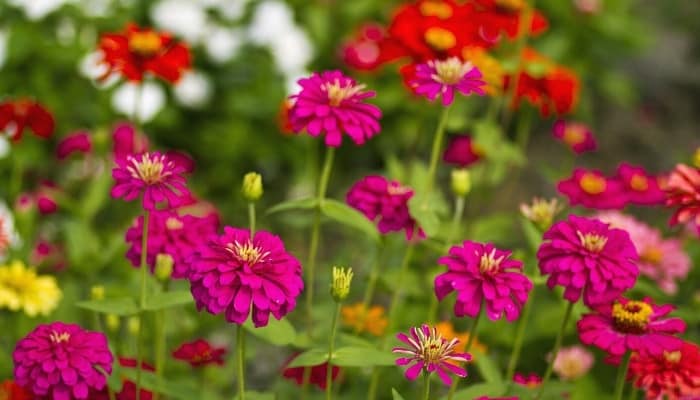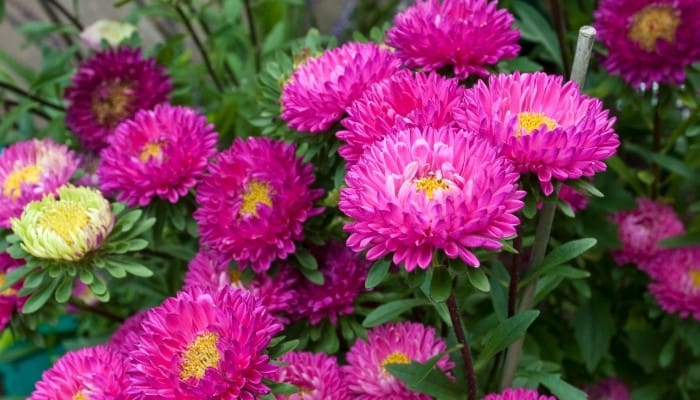Creating a garden that blossoms throughout the year requires careful preparation and patience.
Gladiolus are a great addition to your garden because they are perennial and have a long blooming season from summer through the frost until they can no longer survive.
While gladioli grow in a wide variety of reds, pinks, yellows, purples, greens, oranges, and white, adding other levels of heights, bloom times, and colors from other species is a great way to have blooms all season long.
Check out the list below for 20 great varieties to plant alongside your gladioli that are sure to bring a rainbow to your landscape!
1. Dahlias

With colors that span the spectrum, dahlias will bloom with large flowers that open in midsummer through fall.
They are considered perennial with their tubers but can be planted from seed and will bloom the same season.
- Average mature size: 4-5 feet tall, 1-2 feet wide
- Bloom time: Midsummer through fall
- Recommended varieties: Linda’s Baby, Cornell Bronze, Happy Single First Love
2. Bearded Iris

Iris germanica is one of the more popular varieties of iris and is the easiest to grow. It is more intricate with its “beard” and comes in yellow, purple, black, white, maroon, and orange.
It is perennial, and its rhizomes will naturalize in the soil spreading over a few seasons.
- Average mature size: 1-3 feet tall, 1-2 feet wide
- Bloom time: Spring, some hybrids will bloom again in late summer as well
- Recommended varieties: Again and Again, American Classic, Beatnick, Big Blue Eyes
3. Ornamental Onion

Alliums are great to grow since they are drought and cold hardy, are mostly pest resistant, and are perennial. They have globe-shaped flowers that bloom in shades of pink, purple, yellow, white, and green.
- Average mature size: 1-4 feet tall, 3-10 inches wide
- Bloom time: Spring and fall
- Recommended varieties: Japanese Onion, Globemaster, Purple Sensation
4. Lupine

Also commonly known as bluebonnet, lupine can be both perennial and annual, blooming in an abundance of different colors. It is a wildflower that is native to the majority of North America.
- Average mature size: 3-4 feet tall, 1-5 feet wide
- Bloom time: Spring and summer
- Recommended varieties: Wild Lupine, Gallery Series, Minarette
5. Peonies

Peonies are a long-living perennial variety that grows in six different flower types: single, semi-double, double, anemone, Japanese, and bomb. Many also have a fragrance that is sure to delight!
- Average mature size: 2-3 feet tall, 3-4 feet wide
- Bloom time: Spring through early summer
- Recommended varieties: Firelight, Elsa Sass, Early Scout
6. Zinnias

Zinnias are fast-growing annuals that bloom abundantly in the warm seasons. They come in a variety of bright colors and will continue to grow new buds for a season of flowers!
- Average mature size: 1-4 feet tall, 6-18 inches wide
- Bloom time: Spring, summer, and fall
- Recommended varieties: Zahara, State Fair, Envy, Benary’s Giant Mix
7. Begonias

There are over 1,800 different species of begonias to choose from! These don’t enjoy harsh direct sunlight so they are great for underplantings or as a way to bring color to a shady area of your porch or patio.
- Average mature size: 8 inches to 2 feet tall and wide
- Bloom time: Early summer through fall
- Recommended varieties: Solenia Dusty Rose, Mocaa Yellow, Million Kisses, Ambassador Rose
8. Daylilies

A resilient easy-to-grow choice of flower that will naturalize after a few seasons. Its blooms only last one day and come in shades of orange, gold, yellow, red, or purple.
- Average mature size: 1-4 feet high, 1-2 feet wide.
- Bloom time: Summer
- Recommended varieties: Lilting Belle, Siloam Betty Barns, Orange Velvet, Peacock Maiden
9. Lilies

A group of perennial plants with a variety of bloom shapes, there are 9 different types of true lilies, all showy in their own way. They flower in shades of white, pink, yellow, orange, and red.
- Average mature size: 2-6 feet tall, 1-3 feet wide.
- Bloom time: Early summer through fall
- Recommended varieties: Easter Lily, Tiger, Lily, Casablanca, Tiny Bee, Lolipop
10. Calla Lilies

Not cold hardy, calla lilies only grow in USDA Zones 8 through 10 as a perennial but can be grown as an annual in lower Zones during the summer months.
They bloom in shades of white, pink, coral, maroon, orange, and yellow.
- Average mature size: 2-3 feet tall, 1-2 feet wide
- Bloom time: Summer
- Recommended varieties: Picasso, Red Alert, Siberia, Purple Sensation, Odessa
11. Tuberose

A tuber-type flower that blooms with a strong fragrance, tuberoses grow panicles of flowers on stems that grow from lily-like leaves. You’ll find species with blooms of pink, yellow, white, red, and cream.
- Average mature size: 2-3 feet tall, wide
- Bloom time: Mid to late summer
- Recommended varieties: Double Pearl, Single Mexican, Yellow Baby, Shringar
12. Oriental Poppies

One of the largest blooming varieties of poppies, they will show orange, red, pink, purple, and white flowers that stand among tall stems.
They are perennial and have naturalized in the lowers North American climates.
- Average mature size: 1-3 feet tall, 1-2 feet wide
- Bloom time: Spring and summer
- Recommended varieties: Maiden’s blush, Beauty of Livermore, Garden Glory, Manhattan
13. Blazing Star

Liatris spicata is a North American perennial wildflower that blooms with many panicles of maroon, red, pink, or purple flowers.
- Average mature size: 2-5 feet tall, 9-18 inches wide
- Bloom time: Summer to early fall
- Recommended varieties: Rocky mountain, Cylindrical, Prairie
14. Aster

A long-living perennial that is native to North America, asters will bloom seasonally in purple, blue, pink, and white flowers.
- Average mature size: 1-6 feet tall, 1-4 feet wide
- Bloom time: Summer and fall
- Recommended varieties: Calico, New England, Silky, Sky Blue
15. Daffodils

Some of the first bulb-type flowers to grow in the spring, daffodils come in shades of yellow, peach, orange, and white or cream. They are perennial, naturalize easily, and give off a lovely fragrance.
- Average mature size: 6-30 inches tall, 6-12 inches wide
- Bloom time: Spring
- Recommended varieties: Golden Ducat, Orange Progress, Pink Pride, Cheerfulness, Jetfire
16. Cuphea

Cuphea is an annual that grows lush foliage intermingled with tubular flowers of different shapes and sizes.
They will bloom with orange, yellow, red, white, purple, and pink flowers in unique color combinations.
- Average mature size: 1-3 feet tall and wide
- Bloom time: Spring, summer, and fall
- Recommended varieties: Minnie Mouse, Tiny Mice, Mexican Heather, Totally Tempted
17. Dianthus

Dianthus, more commonly known as carnations or sweet Williams, grow in annual, perennial, and even biennial forms!
They will grow in small bushes, upright, or in a trailing fashion blooming with white, lilac, pink, and red flowers.
- Average mature size: 6-36 inches tall, 6-24 inches wide
- Bloom time: Spring, summer, and fall
- Recommended varieties: Sweet William, Arctic fire, Rose de Mai, First Love
18. Vincas

Known also as periwinkle, this low-growing annual blooms with white, pink, red, and purple flowers.
It prefers full sun or partial shade and is considered toxic to pets and humans so watch your dogs, cats, and children carefully.
- Average mature size: 6 to 18 inches tall and wide
- Bloom time: Summer, fall
- Recommended varieties: Madagascar Periwinkle, Alba, Bowles, Flore Pleno, Variegata
19. Foxglove

Members of the Digitalis genus have tall flowering talks and bright blooms of pink, purple, red, white, and yellow that only begin to bloom in their second season of growth.
Be cautious because foxglove is poisonous to animals and humans!
- Average mature size: 2-5 feet tall, 1-2 feet wide
- Bloom time: Late spring, early summer
- Recommended varieties: Digiplexis, Camelot, Foxy, Candy Mountain, Goldcrest
20. Delphinium

Also known as larkspur, this plant blooms on long panicles with blue, purple, red, white, and yellow flowers.
There are many different species that grow in annual, biannual, or perennial habits that are all poisonous to humans and pets.
- Average mature size: 1-6 feet tall, 1-2 feet wide
- Bloom time: Summer
- Recommended varieties: Morning Lights, Princess Caroline, Summer Skies, Sweethearts
Conclusion
Since gladiolus plants bloom in summer through fall, it is good to add a flowering species that will bloom earlier in the season.
Planting other flowers that bloom at the same time will help to diversify your blooms, adding colors and enticing pollinators to stop by!

